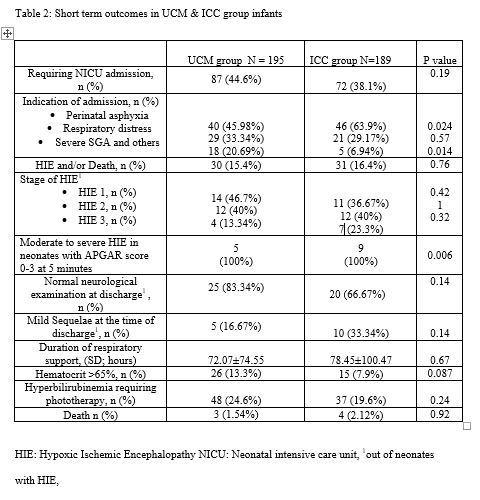Neonatal/Infant Resuscitation
Category: Abstract Submission
Neonatal/Infant Resuscitation I
472 - Comparison of Umbilical Cord Milking with Immediate Cord Clamping in full term neonates requiring resuscitation – A randomized control trial from a low-and-middle income country
Saturday, April 23, 2022
3:30 PM - 6:00 PM US MT
Poster Number: 472
Publication Number: 472.230
Publication Number: 472.230
Sushma Nangia, Lady Hardinge Medical College & Kalawati Saran Children's Hospital, New Delhi, Delhi, India; Gunjana Kumar, others, NEW DELHI, India, Delhi, India; Manju Puri, Others, Delhi, Delhi, India; Arvind Saili, Lady Hardinge Medical College, New Delhi, Delhi, India

Sushma Nangia, MBBS, MD, DM
Neonatologist
Lady Hardinge Medical College & Kalawati Saran Children's Hospital
New Delhi, Delhi, India
Presenting Author(s)
Background: Over the past decade, there has been growing evidence that placental transfusion using delayed cord clamping is beneficial in both full term and preterm neonates. Meanwhile, there is uncertainty about the best method of cord management for infants that require resuscitation at birth. Intact cord resuscitation using bedside resuscitation trolley is being evaluated in research settings as of now which may be difficult to implement due to logistic issues in low resource settings. Intact umbilical cord milking (UCM) may serve as a good alternative if found useful.
Objective: This study was planned to compare the effect of intact umbilical cord milking (UCM) over immediate cord clamping (ICC) on incidence or severity of hypoxic ischemic encephalopathy and other outcomes in full term infants requiring resuscitation.
Design/Methods: The present randomized controlled trial, conducted at a tertiary care centre in a low-and-middle income country (LMIC) enrolled 384 vaginally born full term neonates (≥ 37 weeks) who did not cry immediately after birth and required resuscitation to initiate breathing. This study was conducted over a time frame of 24 months from April 2019 to March 2021. Of the 384 eligible neonates recruited, 195 were randomised to UCM group, and 189 to the ICC group.
Results: Baseline characteristics were comparable between the two groups. There was no significant difference in the incidence of primary outcome of hypoxic ischemic encephalopathy and/or death (UCM: 15.4 % vs ICC: 16.4%; p=0.76). Although the proportion of babies requiring NICU admission in the two groups was similar, but in the UCM group, 46% required admission secondary to perinatal asphyxia as against 64% in the ICC group, which was statistically significant; OR (95%CI), 0.48 (0.25 to 0.91), p-value 0.024. Incidence of moderate to severe HIE in neonates with an APGAR score of 0-3 at 5 minutes was significantly lower in neonates in UCM group (p-0.006). Moreover, there was no adverse outcome associated with UCM as the incidence of polycythemia and hyperbilirubinemia requiring phototherapy remained similar across the two groups.Conclusion(s): Current study from a low-and-middle income country demonstrates that umbilical cord milking in term neonates requiring resuscitation may not be associated with increased risk of HIE and may be associated with decreased incidence of NICU admissions secondary to asphyxia. There were no adverse effects of cord milking, indicating that UCM appears to be a safe and feasible strategy of umbilical cord management in full term infants requiring resuscitation at birth.
Table 1: Demographic Characteristics of Study Subjects.png)
Table 2: Short term outcomes in UCM & ICC group infants
Objective: This study was planned to compare the effect of intact umbilical cord milking (UCM) over immediate cord clamping (ICC) on incidence or severity of hypoxic ischemic encephalopathy and other outcomes in full term infants requiring resuscitation.
Design/Methods: The present randomized controlled trial, conducted at a tertiary care centre in a low-and-middle income country (LMIC) enrolled 384 vaginally born full term neonates (≥ 37 weeks) who did not cry immediately after birth and required resuscitation to initiate breathing. This study was conducted over a time frame of 24 months from April 2019 to March 2021. Of the 384 eligible neonates recruited, 195 were randomised to UCM group, and 189 to the ICC group.
Results: Baseline characteristics were comparable between the two groups. There was no significant difference in the incidence of primary outcome of hypoxic ischemic encephalopathy and/or death (UCM: 15.4 % vs ICC: 16.4%; p=0.76). Although the proportion of babies requiring NICU admission in the two groups was similar, but in the UCM group, 46% required admission secondary to perinatal asphyxia as against 64% in the ICC group, which was statistically significant; OR (95%CI), 0.48 (0.25 to 0.91), p-value 0.024. Incidence of moderate to severe HIE in neonates with an APGAR score of 0-3 at 5 minutes was significantly lower in neonates in UCM group (p-0.006). Moreover, there was no adverse outcome associated with UCM as the incidence of polycythemia and hyperbilirubinemia requiring phototherapy remained similar across the two groups.Conclusion(s): Current study from a low-and-middle income country demonstrates that umbilical cord milking in term neonates requiring resuscitation may not be associated with increased risk of HIE and may be associated with decreased incidence of NICU admissions secondary to asphyxia. There were no adverse effects of cord milking, indicating that UCM appears to be a safe and feasible strategy of umbilical cord management in full term infants requiring resuscitation at birth.
Table 1: Demographic Characteristics of Study Subjects
.png)
Table 2: Short term outcomes in UCM & ICC group infants

